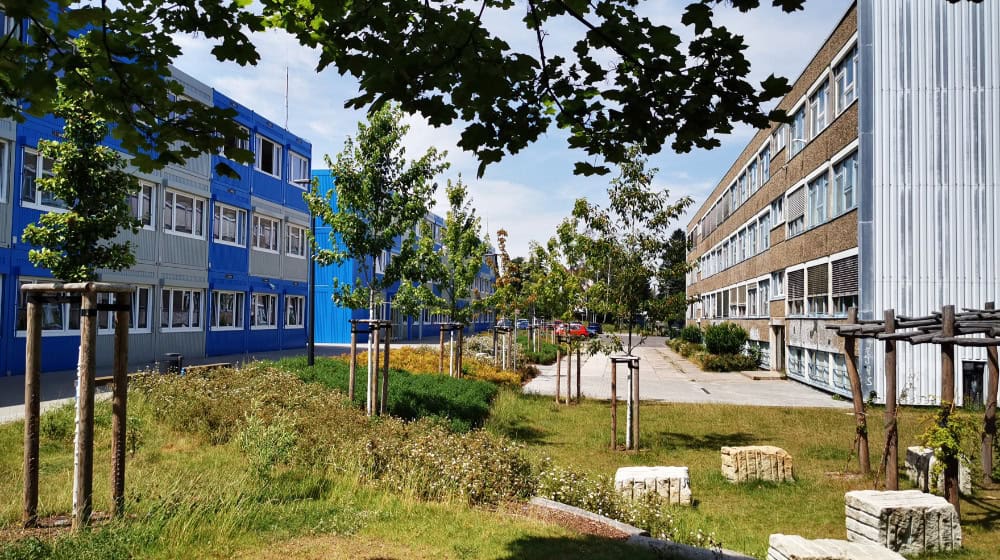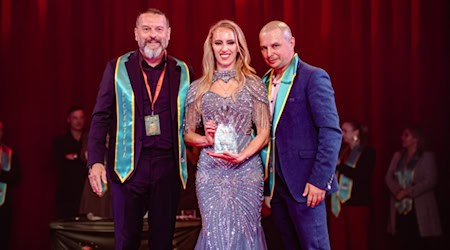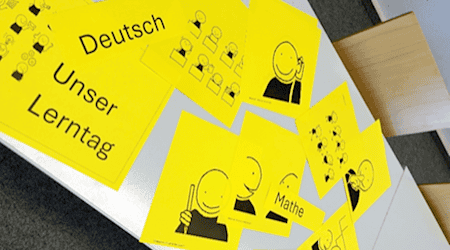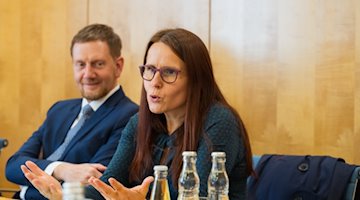In the current school year 2024/25, around 830 students in grades 1 to 10 from the entire Dresden city area and neighboring communities are studying at the Dresden University School. Innovative teaching-learning formats and a contemporary school organization are being tested and researched in the school trial of the Technische Universität Dresden (TUD) and the city of Dresden. The focus of school development is now moving away from the organization of teaching in the younger grades towards the development of structures in the final grades. For the second time in the school's young history, final examinations will be held in the beginning school year, and for the first time, the young people in the qualification level will also be preparing for the Realschule examination. The integration of the Ukrainian pupils and teachers into the school community is also progressing.
Growing school community and learning in a tied all-day school
On August 19, 2019, the University School Dresden (USD) opened its doors for the first time to 200 pupils in grades 1, 2, 3 and 5. In the 2024/25 school year, not only was a second container building added to the old GDR building, but 830 children and young people in grades 1 to 10 are now learning here in a cross-grade and interdisciplinary way with a focus on their individual learning path. By the 2026/27 school year, the community school will grow to around 1,000 pupils up to grade 12.
Cooperative learning with individual learning paths for such a large group of learners is made possible by an innovative digital infrastructure for school and learning management and an agile distribution of resources. In the tied all-day program at primary level, two people per home group - a trained teacher and an educator - provide learning support for first-year students. This model for dovetailing after-school care and school is unique in Saxony and other educational institutions and providers can learn from it to counter the shortage of teachers.
Strong performance in the school trial despite scarce resources
As a public school trial, the Dresden University School has been testing and researching how a school of the future can function with contemporary teaching and learning formats for over 15 years under the scientific supervision of the TUD. Scientific Director Prof. Anke Langner is optimistic at the start of the second third of the project: "The school is growing and developing. The results of the first graduates show what the concept of a "school for all" can achieve: actually more than a mainstream school - with the same available resources. The project was launched in the knowledge that we would have to prove ourselves, even under adverse conditions, to build and shape the school of the future. We have done this and yet we are also surprised that we still have to do this even after five years of solid work. After all, the struggle for the very concrete basic equipment of rooms and the provision of a school building that is appropriate and necessary for the number of pupils costs the school community a great deal of energy. We would much rather devote this energy directly to the pupils and to working with other schools that want to join us on the journey of creating a school for the pupils."
For Headmistress Maxi Heß, the school community is starting a new school year with good groundwork, which will be no less exciting than the other years: "Especially because we will be trying out new structures again. We are pleased that every year we succeed in making the necessary changes quickly and consistently so that - and this is always the focus - the individual learning of the pupils can be supported in the best possible way. The motivation for change and further development is unbroken. The school trial is entering its second third and we have not only grown, but perhaps also grown up a little. In addition to further development processes, we can now also focus on the constant adaptation processes." In concrete terms, this means a changed daily structure and an adapted time structure in the new school year, with which the school is responding to the need for a good feedback culture and successful process support.
Children and young people from all over the city
The interest in a place at Dresden University School remains high. There were over 260 applications for the 130 places available in all year groups. The school trial by the City of Dresden and TUD aims to show that a "school for all" enables successful learning and personal development regardless of social background and other individual factors. For this reason, the composition of the student body should be representative of the population of the city of Dresden in terms of gender, support needs, multilingualism and the educational and vocational qualifications of the parents. The high enrolment figures enable a selection of the children and young people admitted according to these criteria.
The current report on the demographics of students at the USD also contains an overview of the distribution of students' places of residence by zip code in the Dresden city area and neighboring towns. This is possible because Dresden University School does not have a fixed school district. This means that children from all over Dresden and the surrounding area in the south of the city can learn together.
With the expansion up to grade 10, the staff now comprises 51 learning assistants, 20 of whom are educators, in line with the staffing ratio for a public school in the Dresden city area. They are supported by school assistants, volunteers and student teachers from the TUD on a semester-long internship.
Next milestones: secondary school leaving certificate and grammar school level development
After the first secondary school leaving certificate in the past school year, the next milestone is now the first secondary school examinations for year 10. "With significantly more exam participants this school year, we will take the next step towards the intermediate school-leaving exams. We are looking forward to these first exams with a due amount of respect because, after six years of school testing, they show us how we have been able to help students grow personally with the university school concept. The first and very successful graduations in the school's young history in the past school year give us an incredible amount of encouragement and confirmation in what we are doing. This experience is also particularly motivating when it comes to structuring the examination procedure and preparations in line with the school experiment. To this end, we will work with the Saxon State Ministry of Culture (SMK) to develop new examination scenarios that correspond to the school trial," emphasizes Maxi Heß.
The school community is already working in parallel to develop the grammar school level. Even in the junior level, pupils continue to learn together in cross-level groups. The school day is structured by project work, and the children and young people choose the content they want to work on according to their individual requirements. The learning guides provide them with the appropriate learning modules and other materials for their work. The learning modules - these units are based on the content of the Saxon framework curriculum and can be selected and worked on individually according to the current learning level and project topic - contain tasks at secondary school level as well as grammar school level.
The aim of the concept of the university community school is also to enable a high degree of permeability for the pupils. Above all, the students' development until shortly before graduation should determine exactly which school-leaving qualification they are aiming for. This is made more difficult for the grammar school education pathway by a legal regulation: as a prerequisite for the university entrance qualification, continuous instruction in the same second foreign language from grade 6 to 10 is determined. For students who do not choose a second foreign language at the beginning of year 6 - at the University School Dresden this is Spanish - and for later lateral entrants with another second foreign language, this regulation means that the direct path to the Abitur at the USD is currently not possible. However, they can prepare for the Abitur at another (vocational) grammar school after completing the Realschule. Making second language acquisition more flexible on the way to the university entrance qualification as part of the school trial could offer a solution here.
Integration of Ukrainian pupils and students
Some of the 40 Ukrainian pupils are now taking the next step, as around a third of them will be studying full-time in the regular learning groups in the junior and qualification levels from August. For the other third, there will continue to be an integration class with a focus on "German as a second language" work. Since 2022, the first children and young people have initially studied in the learning and play workshop, which later became DaZ preparation classes. The Ukrainian teachers, with their increased knowledge of German, will also be more closely integrated into regular lessons and work regularly in their subjects of art and music.
3 years of the ForUS research center
The accompanying research project will also be celebrating a "small anniversary" at the start of the school year. In November, the Dresden University School ForUS research center at the TUD will be celebrating its third anniversary. In its current report, the Structure and Evaluation Commission for the school trial praises the high innovative strength of the project on the one hand, but at the same time calls for sustainable financing of the scientific support provided by the TUD.
In its fifth year, the school trial is already supporting the regional and supra-regional transfer of innovation, for example in Eastern Saxony, in addition to the further development and expansion process in the growing school. According to the commission's report, the research centre has "made intensive use of the available resources, which is very impressively demonstrated by 9 scientific and 3 practical school publications and 12 applications for third-party funding."
In addition to clarifying the necessary basic funding for the research centre, the committee of renowned educational scientists and experienced practitioners named a new learning house for the growing school community and digitalization at the school in coordination with the city of Dresden as key tasks.
About the University School Dresden
The University School Dresden is a joint project of the state capital Dresden and the Technical University. It is a public and free community school run by the city, where innovative forms of teaching and learning are tested under academic supervision. In addition, it is a training school for future teachers and, in the future, a further education school for teachers. The school trial is being scientifically supported by the ForUS research center at TU Dresden.
Information on the research project at TU Dresden: https://tu-dresden.de/gsw/unischule
Information on the Dresden University School: https://universitaetsschule.org
You can find insights into the research project and everyday school life on various social media channels under @unischuleTUD: Facebook, X-Twitter, Instagram, YouTube and LinkedIn. You can also regularly read news from the Dresden University School project in the Newsletter of the Humanities and Social Sciences Division.









